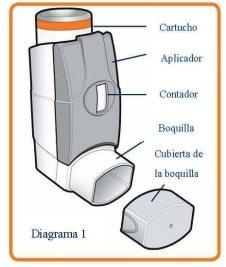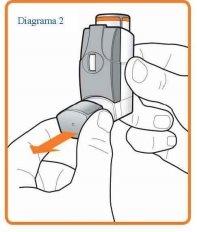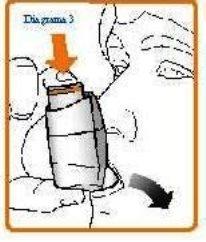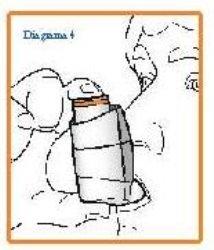

FLUTIFORM 50 microgramas / 5 microgramas SUSPENSÃO PARA INALAÇÃO em embalagem pressurizada

Pergunte a um médico sobre a prescrição de FLUTIFORM 50 microgramas / 5 microgramas SUSPENSÃO PARA INALAÇÃO em embalagem pressurizada

Como usar FLUTIFORM 50 microgramas / 5 microgramas SUSPENSÃO PARA INALAÇÃO em embalagem pressurizada
Introdução
Prospecto: informação para o utilizador
Flutiform 50 microgramas/5 microgramas/inalação, suspensão para inalação em embalagem a pressão
Fluticasona propionato/formoterol fumarato dihidrato
Leia todo o prospecto atentamente antes de começar a usar este medicamento, porque contém informações importantes para si.
- Conserva este prospecto, porque pode ter que voltar a lê-lo.
- Se tiver alguma dúvida, consulte o seu médico ou farmacêutico ou enfermeiro.
- Este medicamento foi prescrito apenas para si e não deve dá-lo a outras pessoas, mesmo que tenham os mesmos sintomas que si, porque pode prejudicá-las.
- Se experimentar efeitos adversos, consulte o seu médico ou farmacêutico ou enfermeiro, mesmo que se trate de efeitos adversos que não aparecem neste prospecto. Ver seção 4.
Conteúdo do prospecto
- O que é Flutiform e para que é utilizado
- O que necessita saber antes de começar a usar Flutiform
- Como usar Flutiform
- Posíveis efeitos adversos
- Conservação de Flutiform
- Conteúdo do embalagem e informações adicionais
1. O que é Flutiform e para que é utilizado
Nota:
O nome do medicamento é Flutiform suspensão para inalação em embalagem a pressão, no entanto, ao longo deste prospecto é abreviado para Flutiform. Às vezes, é feita referência a uma dose específica.
Flutiform é um inhalador (uma suspensão para inalação em embalagem a pressão) que contém duas substâncias ativas:
- Fluticasona propionato, que pertence a um grupo de medicamentos denominados esteroides. Os esteroides ajudam a reduzir o inchaço e a inflamação nos pulmões.
- Formoterol fumarato dihidrato, que pertence a um grupo de medicamentos chamados agonistas beta2 de ação prolongada. Os agonistas beta2 de ação prolongada são broncodilatadores de ação prolongada que ajudam a que as vias respiratórias nos pulmões permaneçam abertas, facilitando a respiração.
Estas duas substâncias ativas juntas ajudam a melhorar a respiração. O utilizador deve usar este medicamento todos os dias, seguindo as indicações do seu médico.
Este medicamento ajuda a prevenir os problemas respiratórios como a asma e ajuda a evitar a falta de ar e a dificuldade respiratória.No entanto, não funciona se já está tendo um ataque de asma, ou seja, se já está sem ar e com respiração sibilante. Se isso acontecer, terá que usar um medicamento de "resgate" de ação rápida como o salbutamol.
2. O que necessita saber antes de começar a usar Flutiform
Não use Flutiform se:
- é alérgico a fluticasona propionato, formoterol fumarato ou a qualquer um dos outros componentes deste medicamento (incluídos na seção 6).
Advertências e precauções
Consulte o seu médico, farmacêutico ou enfermeiro antes de começar a usar Flutiform.
Antes de iniciar o tratamento com este inhalador, informe o seu médico ou farmacêutico ou enfermeiro se tem:
- Tuberculose (TB) atualmente ou se a teve no passado. Os sintomas incluem uma tosse persistente, muitas vezes com fleuma sanguinolenta, febre, cansaço, perda de apetite, perda de peso e suores noturnos.
- Uma infecção nos pulmões ou no peito.
- Problemas de coração, tais como problemas com o fluxo de sangue para o coração ou estreitamento de uma das válvulas cardíacas (a válvula aórtica), insuficiência cardíaca, que pode causar dificuldade para respirar ou inchaço dos tornozelos, uma patologia em que o músculo cardíaco está aumentado (cardiomiopatia hipertrófica obstructiva), um ritmo irregular do coração (arritmias cardíacas) ou se lhe disseram que o seu eletrocardiograma do coração é anormal (prolongamento do intervalo QTc).
- Um abaulamento anormal da parede de um vaso sanguíneo (aneurisma).
- Diabetes.
- Pressão arterial alta.
- Hiperatividade da glândula tireoide, que pode causar aumento do apetite, perda de peso ou suoração (tirotoxicose).
- Níveis sanguíneos de potássio baixos, que podem causar fraqueza muscular, espasmos musculares ou ritmo cardíaco anormal (hipopotasemia).
- Mal funcionamento da glândula suprarrenal (se a glândula suprarrenal não está funcionando corretamente, é possível que tenha sintomas como dores de cabeça, fraqueza, cansaço, dor abdominal, perda de apetite, perda de peso, tonturas, pressão arterial muito baixa, diarreia, sensação de mal-estar ou ataques) ou um tumor da glândula suprarrenal (feocromocitoma).
- Problemas hepáticos.
Entre em contato com o seu médico se experimentar visão borrosa ou outras alterações visuais.
Se vai ser submetido a uma intervenção cirúrgica ou está extremamente estressado, diga ao seu médico, porque pode precisar de tratamento adicional com esteroides para controlar a asma.
Outros medicamentos e Flutiform
Informa o seu médico ou farmacêutico se está tomando, tomou recentemente ou pode ter que tomar qualquer outro medicamento, mesmo os adquiridos sem receita. Se usar este inhalador com outros medicamentos, o efeito deste inhalador ou do outro medicamento pode alterar-se.
Informa o seu médico ou farmacêutico se está tomando os seguintes medicamentos:
- Medicamentos conhecidos como betabloqueantes (como o atenolol para tratar a hipertensão arterial, o sotalol para tratar os ritmos cardíacos irregulares, o metoprolol para tratar o ritmo cardíaco rápido ou o timolol em gotas oculares para tratar o glaucoma).
- Outros medicamentos utilizados para tratar a asma ou as alterações respiratórias (como a teofilina ou a aminofilina).
- Medicamentos que contêm adrenalina ou substâncias relacionadas (incluyendo outros beta agonistas como o salbutamol ou os beta antagonistas como o atenolol, o metoprolol, o propranolol, o timolol). Não devem ser utilizados outros agonistas beta2 de ação prolongada juntamente com este inhalador. Se a asma piorar entre as administrações de Flutiform, deve usar o seu inhalador “de resgate” de ação rápida, para obter um alívio imediato.
- Medicamentos para tratar reações alérgicas (antihistamínicos).
- Medicamentos para tratar a hipertensão arterial ou a acumulação de líquidos mediante o aumento da quantidade de urina produzida (diuréticos).
- Medicamentos utilizados para tratar a insuficiência cardíaca (como a digoxina).
- Medicamentos para tratar os ritmos cardíacos anormais (tais como a quinidina, a disopiramida, a procainamida).
- Medicamentos para tratar os sintomas da depressão ou os transtornos mentais, como os inibidores da monoamino oxidase (por exemplo fenelzina e isocarboxazida), os antidepresivos tricíclicos (por exemplo a amitriptilina e a imipramina), ou se tomou qualquer um desses tipos de medicamentos nas últimas duas semanas.
- Medicamentos utilizados para tratar os transtornos psiquiátricos ou mentais (fenotiazinas ou antipsicóticos).
- Outros medicamentos que contêm esteroides.
- Medicamentos antifúngicos (como o ketoconazol ou o itraconazol).
- Alguns medicamentos podem aumentar os efeitos do Flutiform e o seu médico pode querer supervisioná-lo cuidadosamente se está tomando esses medicamentos (incluyendo alguns medicamentos para o VIH: ritonavir, atazanavir, indinavir, nelfinavir, saquinavir ou cobicistat).
- Antibióticos (como a claritromicina, a telitromicina ou a furazolidona).
- Medicamentos para tratar a doença de Parkinson (levodopa).
- Medicamentos para tratar uma baixa atividade da glândula tireoide (levotiroxina).
- Medicamentos para tratar a doença de Hodgkin (procarbazina).
- Medicamentos para provocar o parto (oxitocina).
Se vai ser operado sob anestesia geral, por favor, comunique ao seu médico no hospital que está utilizando este inhalador.
Gravidez e amamentação
Se está grávida ou em período de amamentação, acredita que possa estar grávida ou tem intenção de engravidar, consulte o seu médico ou farmacêutico antes de utilizar este medicamento. O médico aconselhará se deve utilizar este medicamento.
Condução e uso de máquinas
Não é provável que este medicamento afete a capacidade de conduzir ou usar máquinas.
Flutiform contém etanol (álcool) e cromoglicato de sódio
Este medicamento contém 2 mg de álcool em cada dose (2 inalações). A quantidade em cada dose é equivalente a menos de 1 ml de cerveja ou 1 ml de vinho. A pequena quantidade de álcool neste medicamento não tem efeitos destacados. Também contém uma quantidade muito pequena de cromoglicato de sódio, no entanto, os pacientes que estiverem tomando atualmente cromoglicato (utilizado para tratar a asma, a rinite alérgica e a conjuntivite alérgica) devem continuar tomando-o com normalidade.
3. Como usar Flutiform
Siga exatamente as instruções de administração deste medicamento indicadas pelo seu médico ou farmacêutico. Em caso de dúvida, consulte novamente o seu médico ou farmacêutico.
Deve usar o seu inhalador regularmente, ou seja, duas inalações (pulsões) pela manhã e duas inalações (pulsões) à noite todos os dias, com o fim de obter o maior benefício do seu inhalador, a menos que o seu médico lhe dê outras indicações ou lhe recomende que interrompa o tratamento. Não se administre mais doses do que as prescritas. O seu médico pode ter-lhe prescrito o seu inhalador para uma indicação diferente da asma ou para uma dose diferente da prescrita normalmente e como é descrito neste prospecto. Deve usar sempre o seu inhalador exatamente como lhe tenha recomendado o seu médico. Se não tiver certeza de quanto deve administrar ou com que frequência deve usar o inhalador, por favor, consulte o seu médico ou farmacêutico.
Adultos, adolescentes e crianças de 5 anos e mais velhos
A dose habitual é de duas inalações duas vezes ao dia, ou seja, duas inalações (pulsões) pela manhã e duas à noite. O seu médico prescreverá a dose necessária para tratar a sua asma. Apenas os adultosdevem usar o inhalador de maior dose (Flutiform 250 microgramas/10 microgramas).
Apenas os adultos e adolescentes com mais de 12 anos de idade devem usar o inhalador de dose intermediária (Flutiform 125 microgramas/5 microgramas).
Flutiform não deve ser utilizado em crianças menores de 5 anos de idade.
Instruções de uso
Leia o prospecto atentamente antes de usar o inhalador e siga as instruções de uso do texto e dos diagramas que se seguem. O seu médico ou farmacêutico ensinar-lhe-á como usar o seu inhalador corretamente. O medicamento está dentro, em um cartucho de aerosol (ver o Diagrama 1) que, por sua vez, está dentro de um dispensador de plástico (também conhecido como aplicador). O aplicador também tem um contador para indicar-lhe quantas inalações (pulsões) restam, após o ter carregado. Este contador também tem um código de cores. Começa em verde, depois, quando restarem menos de 50 pulsões (inalações), muda para amarelo e quando restarem menos de 30 pulsões (inalações), muda para vermelho. Quando estiver perto do zero, deve contactar o seu médico para repor o inhalador. Não use o seu inhalador quando o contador marcar zero.

Antes de usar o seu inhalador pela primeira vez, ou se não o usou durante um período de mais de 3 dias, ou se esteve exposto a condições de congelamento
Se o seu inhalador é novo ou não o usou durante mais de 3 dias, deve carregá-lo para garantir que funciona corretamente e que lhe administra a dose correta.
Se o seu inhalador esteve exposto a temperaturas de congelamento, deve deixá-lo atingir a temperatura ambiente durante 30 minutos e, em seguida, deve carregá-lo para garantir que funciona corretamente e que lhe administra a dose correta.
Para carregar o inhalador
- Retire a capa do bocal e agite bem o inhalador.
- Aponte com o bocal longe de si e libere uma descarga (uma pulsão) pressionando para baixo o cartucho de aerosol. Este passo deve ser realizado 4 vezes.
O inhalador sempre deve ser agitado imediatamente antes do seu uso.
Uso do inhalador
Se, durante o uso de Flutiform, sentir que tem dificuldade para respirar ou sibilância, deve continuar usando Flutiform, mas acuda ao seu médico o mais rápido possível, porque pode precisar de tratamento adicional. Uma vez que a asma esteja bem controlada, o seu médico pode considerar oportuno reduzir gradualmente a dose de Flutiform.
Realize lentamente os passos 2 a 5 que se seguem.

- Retire a capa do bocal (ver Diagrama 2) e verifique se o seu inhalador está limpo e sem pó.
- Agite o inhalador imediatamente antes de cada descarga (pulsão) para garantir que o conteúdo do seu inhalador está uniformemente misturado.
- Sente-se ereto ou permaneça de pé. Exale até onde se sentir confortável e o mais lento e profundamente possível.

- Segure o seu inhalador na vertical (como mostrado no Diagrama 3) e coloque o bocal na sua boca, rodeando-o com os lábios. Segure o inhalador com o(s) polegar(es) na base do bocal e com o(s) indicador(es) na parte superior do inhalador. Não morda o bocal.
- Inspire lenta e profundamente pela boca e, ao mesmo tempo, pressione para baixo o cartucho do aerosol para liberar uma descarga (pulsão). Continue inspirando de maneira constante e profunda (a ser possível em torno de 2-3 segundos para as crianças e 4-5 segundos para os adultos).

- Enquanto contém a respiração, retire o inhalador da sua boca. Continue contendo a respiração enquanto se sentir confortável. Não exhale dentro do inhalador.
- Para a segunda descarga (pulsão), mantenha o inhalador na posição vertical, depois repita os passos 2 a 6.
- Coloque a capa do bocal.
Pode praticar diante de um espelho. Se, quando usar o seu inhalador, vir sair uma “fina névoa” da parte de cima do inhalador ou ao redor da boca, pode ser que não tenha inhalado o medicamento corretamente. Administre outra dose, repetindo o processo desde o passo 2 explicado anteriormente.
Depois de cada inalação, enxágue sempre a boca, faça gárgaras com água ou escove os dentes e cuspa os resíduos. Isso pode ajudar a prevenir o risco de desenvolver feridas na boca e na garganta ou rouquidão.
Se tiver pouca força nas mãos, pode ser mais fácil segurar o inhalador com ambas as mãos, colocando os dois dedos indicadores no cartucho do inhalador e ambos os polegares na base do inhalador.
Se tiver dificuldade em usar o seu inhalador, o seu médico pode fornecer-lhe um dispositivo chamado câmara espaciadora AeroChamber Plus® Flow-Vu®, para ajudar a que o medicamento chegue aos seus pulmões adequadamente. O seu médico ou farmacêutico informar-lhe-á sobre como usar a câmara espaciadora AeroChamber Plus® Flow-Vu® com o seu inhalador. A câmara AeroChamber Plus® Flow-Vu® vem com instruções de uso e de cuidado e limpeza que deve ler atentamente.
O cuidado do seu inhalador
É importante que siga estas instruções cuidadosamente e que limpe o seu inhalador semanalmente. Para limpar o seu inhalador:
- Retire a capa do bocal.
- Não extraia o cartucho com o aerosol da carcassa de plástico.
- Limpe o interior e exterior do bocal e da carcassa de plástico com um pano seco e limpo ou com um lenço de papel.
- Volta a colocar a capa do bocal.
- Não mergulhe o cartucho de metal em água.
Se usar mais Flutiform do que deve
É importante que se administre as suas doses como lhe tenha indicado o seu médico ou farmacêutico. Não deve aumentar ou diminuir a sua dose sem conselho médico.
Se usar mais Flutiform do que deve, entre em contato imediatamente com o seu médico ou farmacêutico para que lhe aconselhem. Pode sofrer dor intensa no peito (angina de peito), pressão arterial alta ou baixa, dor de cabeça, cãibras musculares, dificuldade para dormir, nervosismo, secura de boca, perda de apetite, agitação, ataques ou convulsões. Pode se sentir instável, tonto, fraco, cansado, doente ou sofrer mal-estar geral. Também pode notar alterações na velocidade dos seus batimentos cardíacos e pode ter níveis baixos de potássio no sangue ou um aumento da quantidade de açúcar no sangue. Também pode sofrer sintomas como dor abdominal, sensação de mal-estar, perda de peso, diminuição do nível de consciência (que pode produzir sonolência ou confusão) ou níveis baixos de açúcar no sangue.
Se se administrar mais doses do que as prescritas durante um longo período de tempo, deve falar com o seu médico ou farmacêutico para que lhe indique como agir. Isso é porque as doses elevadas podem reduzir a quantidade de hormonas esteroides produzidas normalmente pelas glândulas suprarrenais (ver seção 4 “Posíveis efeitos adversos”).
Se esquecer de usar Flutiform
Se se esquecer de inhalar uma dose, faça-o assim que se lembrar. No entanto, se faltar muito pouco tempo para a administração da próxima dose, prescinda da dose esquecida. Não se administre uma dose dupla para compensar as doses esquecidas.
Se interromper o tratamento com Flutiform
É muito importante que se administre este inhalador todos os dias, seguindo as indicações do seu médico, mesmo que se sinta bem, porque lhe ajudará a controlar a asma. Se desejar deixar de usar o seu inhalador, fale antes com o seu médico. Ele lhe indicará como fazer; habitualmente, diminuindo a dose gradualmente, para não desencadear um ataque de asma.
4. Efeitos adversos possíveis
Tal como todos os medicamentos, este inhalador pode produzir efeitos adversos, embora nem todas as pessoas os sofram. O seu médico prescrever-lhe-á a menor dose necessária para o controlo da sua asma, o que pode reduzir a possibilidade de que apareçam efeitos adversos.
Todos os medicamentos podem produzir reações alérgicas, embora as reações alérgicas graves sejam raras. Informe o seu médico imediatamente se os seus párpados, face, garganta, língua ou lábios se inflamarem repentinamente; se tiver uma erupção cutânea ou sentir picazón, especialmente se se apresentar em todo o seu corpo; se tiver sintomas como tonturas, sensação de aturdimiento ou desmaio, ou mudanças repentinas na sua forma de respirar, como um aumento das sibilâncias ou dificuldade para respirar.
Tal como com outros inhaladores, a sua respiração pode piorar imediatamente após usar o inhalador. Pode notar um aumento das sibilâncias e dificuldade para respirar. Se isto acontecer, deixe de utilizar Flutiform e use o seu inhalador de ‘resgate’ de ação rápida. Entre em contacto com o seu médico imediatamente. Ele fará uma avaliação e pode iniciar um tipo de tratamento diferente. Deve levar o seu inhalador de ‘resgate’ consigo em todo o momento.
Efeitos adversos pouco frequentes (podem afetar até 1 em cada 100 pessoas)
- Pioria da asma.
- Dor de cabeça.
- Tremores.
- Latido cardíaco irregular ou palpitações.
- Tonturas.
- Dificuldade para dormir.
- Alterações na voz / rouquidão.
- Boca seca, feridas ou irritação da garganta.
- Erupção.
Efeitos adversos raros (podem afetar até 1 em cada 1.000 pessoas)
- Aumento da quantidade de açúcar no sangue. Se é diabético, pode precisar controlar o seu açúcar no sangue mais frequentemente e ajustar o seu tratamento habitual para a diabetes. O seu médico pode precisar controlá-lo mais estreitamente.
- Candidíase ou outra infecção por fungos na boca e na garganta.
- Inflamação dos seios paranasais (sinusite).
- Ritmo cardíaco acelerado.
- Dor no peito associada a doença cardíaca.
- Espasmos musculares.
- Tosse ou dificuldade para respirar.
- Diarréia.
- Dispepsia.
- Mudanças no gosto.
- Uma sensação de tontura ou vertigem.
- Sonhos anormais.
- Agitação.
- Coceira na pele.
- Pressão arterial alta.
- Uma sensação de fraqueza incomum.
- Inchaço das mãos, tornozelos ou pés.
Frequência desconhecida:não pode ser estimada a partir dos dados disponíveis
- Visão turva.
- Problemas de sono, depressão ou sentimento de preocupação, agressividade, ansiedade, inquietude, nervosismo, excesso de excitação ou irritabilidade. É mais provável que estes efeitos ocorram em crianças.
Os seguintes efeitos adversos foram associados ao formoterol fumarato, mas não foram registados durante os ensaios clínicos com este inhalador:
- Níveis baixos de potássio, que podem causar fraqueza muscular, espasmos musculares ou alterações do ritmo cardíaco.
- Um eletrocardiograma anormal que potencialmente pode revelar um ritmo cardíaco anormal (prolongamento do intervalo QTc).
- Níveis altos de ácido láctico no sangue.
- Sensação de mal-estar.
- Dor muscular.
Os esteroides inhalados podem afetar a produção normal de hormonas esteroides no seu corpo, especialmente se utilizar doses altas durante um longo período de tempo. Os efeitos incluem:
- Mudanças na densidade mineral óssea (adelgaçamento dos ossos).
- Cataratas (opacidade do cristalino do olho).
- Glaucoma (aumento da pressão ocular).
- Equimoses ou adelgaçamento da pele.
- Maior probabilidade de contrair uma infecção.
- Desaceleração do crescimento de crianças e adolescentes.
- Cara arredondada (cara de lua cheia).
- Um efeito na glândula suprarrenal (uma glândula pequena sobre o rim), que pode fazer com que você apresente sintomas como fraqueza, cansaço, dificuldade para lidar com o estresse, dor abdominal, perda de apetite, perda de peso, dor de cabeça, tonturas, pressão arterial muito baixa, diarreia, sensação de mal-estar ou convulsões.
Estes efeitos são muito menos prováveis que ocorram com os esteroides inhalados do que com os esteroides em comprimidos.
Comunicação de efeitos adversos
Se experimentar qualquer tipo de efeito adverso, consulte o seu médico ou farmacêutico, mesmo que se trate de possíveis efeitos adversos que não aparecem neste folheto. Também pode comunicá-los diretamente através do Sistema Espanhol de Farmacovigilância de Medicamentos de Uso Humano: https://www.notificaRAM.es. Mediante a comunicação de efeitos adversos, você pode contribuir para fornecer mais informações sobre a segurança deste medicamento.
5. Conservação de Flutiform
Mantenha este medicamento fora da vista e do alcance das crianças.
Não utilize este medicamento após a data de validade que aparece na etiqueta, na bolsa de alumínio e na caixa de cartão, após CAD. A data de validade é o último dia do mês que se indica. CAD: 08-2020 significa que não deve utilizar o inhalador após o último dia desse mês, ou seja, agosto de 2020.
Não conserve a uma temperatura superior a 25°C. Não refrigerar ou congelar. Se o inhalador for exposto a condições de congelamento, deixe que se tempere à temperatura ambiente durante 30 minutos e, posteriormente, carregue-o antes de usá-lo (ver seção 3 “Como usar Flutiform”). Não use o inhalador se foi retirado da bolsa de alumínio há mais de 3 meses, ou se o indicador de dose marca '0'.
Não exponha a temperaturas superiores a 50°C. O cartucho de aerosol contém um líquido pressurizado, por isso não deve ser perfurado, quebrado ou queimado o cartucho, mesmo que aparentemente esteja vazio.
Os medicamentos não devem ser jogados nos esgotos nem na lixeira. Deposite os recipientes e os medicamentos que não precisa no Ponto SIGRE da farmácia. Em caso de dúvida, pergunte ao seu farmacêutico como se livrar dos recipientes e dos medicamentos que não precisa. Dessa forma, você ajudará a proteger o meio ambiente.
6. Conteúdo do envase e informações adicionais
Composição de Flutiform
- Os princípios ativos são fluticasona propionato e formoterol fumarato dihidrato. Cada inalação (pulsação) contém 50 microgramas de fluticasona propionato e 5 microgramas de formoterol fumarato dihidrato.
- Os demais componentes (excipientes) são:
- Cromoglicato de sódio
- Etanol
- Apaflurano HFA 227 (propulsor)
Este medicamento contém gases fluorados de efeito estufa.
Cada inhalador contém 11,2 gramas de gás fluorado de efeito estufa HFA227, que correspondem a 0,036 toneladas de CO2 equivalente (potencial de aquecimento global PCG = 3220).
Aspecto de Flutiform e conteúdo do envase
Este inhalador é um cartucho pequeno de aerosol que contém uma suspensão líquida de cor branca a esbranquiçada equipado com uma válvula dosificadora. O cartucho é inserido em um dispensador de plástico cinza e branco (aplicador) com uma tampa para a boquilha de cor cinza claro. Cada inhalador contém 120 descargas (inalações). Há um inhalador em cada envase. O envase múltiplo é de 3 x 1 inhalador (120 inalações).
Pode ser que nem todos os tamanhos de envase sejam comercializados.
Titular da autorização de comercialização e responsável pela fabricação
Titular da autorização de comercialização
Mundipharma Pharmaceuticals, S.L.
Bahía de Pollensa, 11
28042 Madrid
Espanha
Tfn.: 91 3821870
Responsável(s) pela fabricação
Mundipharma DC B.V.
Leusderend 16
3832 RC Leusden
Países Baixos
Este medicamento está autorizado nos Estados-Membros do Espaço Económico Europeu com os seguintes nomes:
Flutiform:
Áustria
Bélgica
Bulgária
Croácia
Chipre
República Checa
Dinamarca
Finlândia
França
Alemanha
Hungria
República da Irlanda
Eslovênia
Islândia
Luxemburgo
Países Baixos
Noruega
Polônia
Portugal
Romênia
República Eslovaca
Espanha
Suécia
Flutiformo:
Itália
Data da última revisão destefolheto:02/2025
A informação detalhada e atualizada deste medicamento está disponível na página Web da Agência Espanhola de Medicamentos e Produtos Sanitários (AEMPS) http://www.aemps.gob.es/

Quanto custa o FLUTIFORM 50 microgramas / 5 microgramas SUSPENSÃO PARA INALAÇÃO em embalagem pressurizada em Espanha em 2025?
O preço médio do FLUTIFORM 50 microgramas / 5 microgramas SUSPENSÃO PARA INALAÇÃO em embalagem pressurizada em dezembro de 2025 é de cerca de 32.86 EUR. Os valores podem variar consoante a região, a farmácia e a necessidade de receita. Confirme sempre com uma farmácia local ou fonte online para obter informações atualizadas.
- País de registo
- Preço médio em farmácia32.86 EUR
- Substância ativa
- Requer receita médicaSim
- Fabricante
- Esta informação é apenas para referência e não constitui aconselhamento médico. Consulte sempre um médico antes de tomar qualquer medicamento. A Oladoctor não se responsabiliza por decisões médicas baseadas neste conteúdo.
- Alternativas a FLUTIFORM 50 microgramas / 5 microgramas SUSPENSÃO PARA INALAÇÃO em embalagem pressurizadaForma farmacêutica: INALAÇÃO PULMONAR, 125 microgramas/5 microgramas/doseSubstância ativa: formoterol and fluticasoneFabricante: Mundipharma Pharmaceuticals S.L.Requer receita médicaForma farmacêutica: INALAÇÃO PULMONAR, 250 microgramas/10 microgramas/doseSubstância ativa: formoterol and fluticasoneFabricante: Mundipharma Pharmaceuticals S.L.Requer receita médicaForma farmacêutica: INALAÇÃO PULMONAR, 50 microgramas/250 microgramasSubstância ativa: salmeterol and fluticasoneFabricante: Sandoz Farmaceutica S.A.Requer receita médica
Médicos online para FLUTIFORM 50 microgramas / 5 microgramas SUSPENSÃO PARA INALAÇÃO em embalagem pressurizada
Avaliação de posologia, efeitos secundários, interações, contraindicações e renovação da receita de FLUTIFORM 50 microgramas / 5 microgramas SUSPENSÃO PARA INALAÇÃO em embalagem pressurizada – sujeita a avaliação médica e regras locais.














